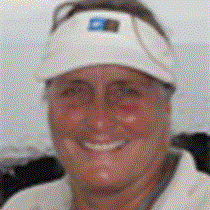Isabela & Fernandina Islands
At the early hour of 0630 I made a quietly excited ship-wide announcement: “There is a huge pod of common dolphins off our bow!” Soon our guests were hurrying on deck, rubbing sleep from their eyes and squinting in the bright, early sunshine.
There were at least a thousand dolphins! We were completely surrounded by them; dolphins were leaping, splashing and cavorting with their cream and gray flanks flashing in the sun. The sea was calm, the sky practically cloudless. The silhouettes of Volcan Wolf and Ecuador were illuminated in the distance and we were all delighted to be on deck enjoying the fresh air and wonderful moment in nature.
Juan Carlos spied a whale spout not far ahead so First Officer John slowed the ship and we waited in suspense for the whale to rise and spout again. It did surface, slightly ahead of the ship and now we got a good look at the dorsal fin and could identify this as a Bryde’s whale – a medium sized baleen whale that has a world wide range throughout the tropics. We glimpsed another whale later, and this one was so close to the ship that we could hear it exhale as it surfaced, but we did not ever see the dorsal fin, so could not be sure what species of whale it was.
Breakfast was plentiful and delicious and we were hungry after the successful hour on deck; following the meal we joined the Captain in the bridge to count down the last ten seconds of latitude as we approached the equator line. As we crossed the line, Jack and Alicia blew the ship’s whistle, and then King Neptune, Queen Nereida and three evil looking pirates paid us a visit. We drank a toast of “iguana blood” (actually black berry juice) and limbo-ed under a banner in celebration of all becoming official “Galapagos Shellbacks!”
Captain Pablo dropped the National Geographic Islander’s anchor below the dramatic cliffs of Punta Vicente Roca and the “pangueros” lowered our four Zodiacs for a cruise along the rough shoreline. We loaded into the boats and motored south first to watch a spectacular blue footed booby feeding frenzy. In my Zodiac we counted 21 sea turtles along the transect line that we follow each week, and we all admired a myriad of all sorts of species: flightless cormorants, brown noddy terns, sea fans, helio-stars, marine iguanas, sea lions, penguins, cup corals and Nazca boobies to name just a few.
Three Zodiacs with guests and Naturalists went snorkeling among the turtles, cormorants, king angel and razor fish, and everyone who ventured into the chilly water had a phenomenal experience! Three resting penguins that were preening and floating on the water’s surface pecked Ian’s mask and pulled at his flippers! A pair of cormorants swam within a foot of us and we watched sea turtles feeding on algae and sleeping on the sandy ocean floor. Juan Carlos, Irene and I found a small juvenile sea turtle, bright orangish in color and with a white plastron, a marine iguana grazing under water and a “ménage a trois” - three courting cormorants doing their aquatic courtship dance among the rocks close to shore. Amazing to have done and seen all of this before lunch!
The afternoon walk at Punta Espinoza was as magical as the morning. This huge dark shield volcano appears lifeless and barren – but only when seen from a distance. Once we were on shore, and strolling along on the pahoehoe lava, we found piles of marine iguanas, nesting cormorants, black lava lizards, more sea lions (of course) and even a couple Galápagos snakes. A hawk flew in and landed on one of the stop signs as some of us were leaving the island and the sun set – a fiery ball of orange – behind the slopes of one of the most active volcanoes in the world: Fernandina. If no clouds blow in tonight, Walter is planning on asking the Captain to turn off the ship’s outside lights and we will star gaze after dinner!




